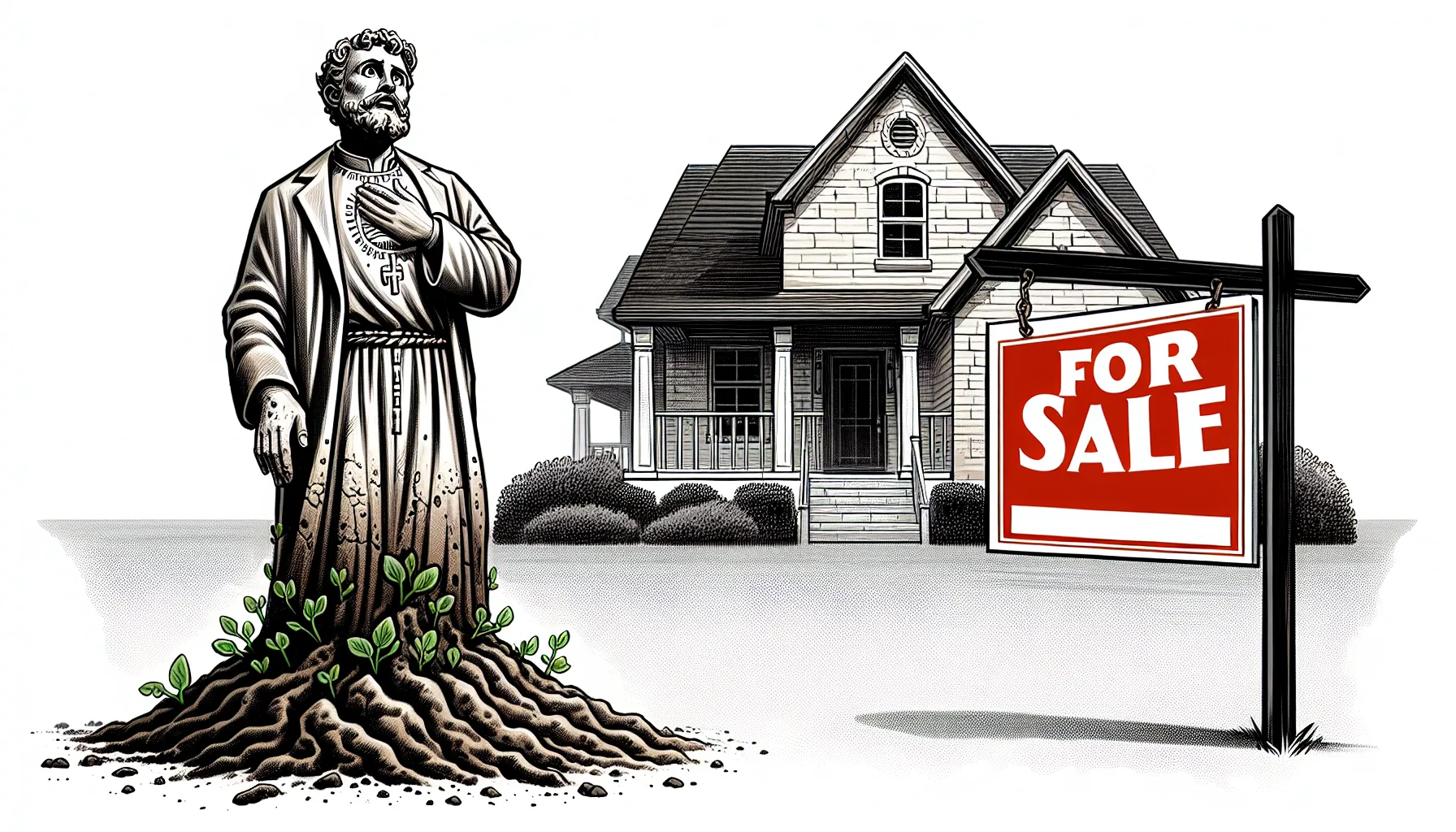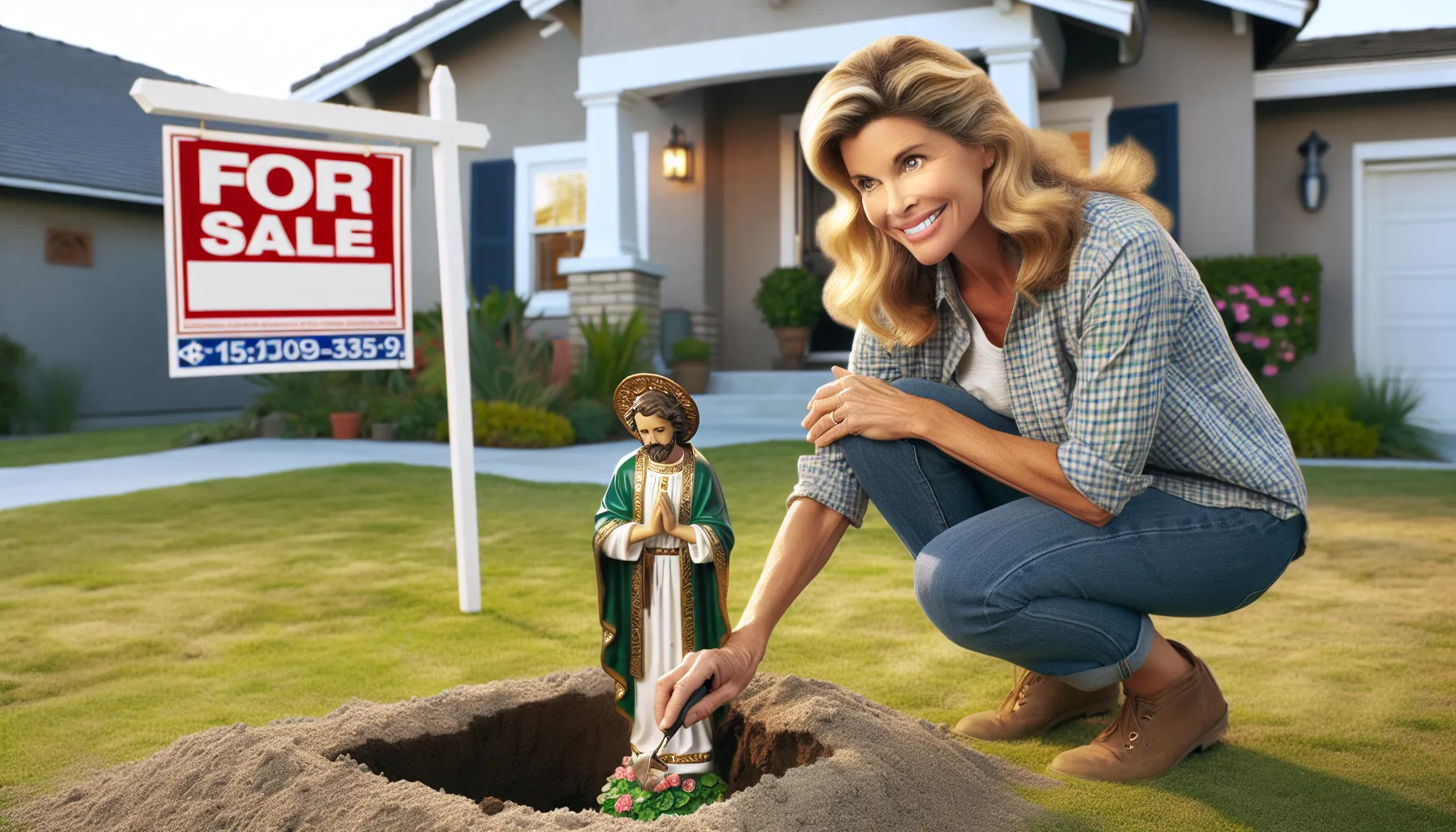Key Takeaways
- The tradition of burying a St. Joseph statue to sell a house is rooted in centuries-old Catholic customs, offering many homeowners comfort and a sense of control during uncertain sales.
- While some sellers report faster offers after completing the ritual, there is no scientific evidence or real estate data confirming its direct impact on home sales.
- The St. Joseph statue practice is symbolic and should not replace proven strategies such as accurate pricing, home staging, transparency, and targeted marketing.
- Real-life testimonials show the ritual can provide emotional support but does not substitute for legal requirements or standard selling procedures.
- Success in selling a home relies on combining practical approaches with personal beliefs, ensuring hope and tradition are balanced with market-based tactics.
Selling a house can feel like a rollercoaster ride—especially when we’re hoping for a quick sale. Over the years, many homeowners have turned to unique traditions to speed things up, and one of the most talked-about is burying a St. Joseph statue in the yard. The idea sounds simple and a bit mysterious: could a small statue really help us find the right buyer faster?
Whether we’re curious about the story behind this ritual or wondering if it actually works, it’s natural to want every possible advantage in a competitive market. Let’s explore the history, the process, and what we should really expect if we decide to give this time-honored tradition a try.
The St. Joseph Statue Tradition Explained
This tradition of burying a St. Joseph statue dates back centuries and centers on the belief that invoking St. Joseph—the patron saint of home and family—can encourage a faster home sale. We find the roots in European Catholic customs, with early records referencing communities who used small St. Joseph medals or figures as part of property prayers. Over time, especially in the US, this evolved into the practice of placing a plastic statue upside down in the yard near the “For Sale” sign.
Most homeowners buy dedicated St. Joseph kits featuring a 3- to 4-inch statue and prayer card. They typically bury the statue head-down, facing the house, based on the idea that St. Joseph “works harder” to free himself—thus helping the property move faster. Retailers, online platforms, and some real estate agents distribute hundreds of thousands of these kits every year, particularly in slower local markets or when owners face tough competition.
We’ve seen the tradition followed alongside modern selling tactics like professional staging, pricing analysis, and digital marketing. While some sellers report quick offers after burying the statue, others note no change in buyer activity. The ritual has no direct legal impact on ownership transfer, appraisal, or disclosure—the real outcomes rely on transparent negotiations, clear title, and contract compliance. Still, this ritual often provides comfort and a sense of action in times of housing uncertainty.
What compels so many sellers to turn to this custom, despite mixed anecdotal results? For many, it’s less about measurable impact and more about feeling proactive during a stressful process. Even when faith-driven traditions don’t move the market, they bridge the gap between hope and effort—reminding us that real estate success blends strategy, process, and mindset.
Origins and Historical Background

Our understanding of the St. Joseph statue tradition begins with its roots in late medieval Europe, where Catholic communities often invoked saints as intercessors in daily life. St. Joseph, recognized as the patron saint of home and family, became a central figure for those seeking stability or favor in matters of property. Early documented examples include European nuns burying medals and small tokens of St. Joseph when asking for land or shelter, signaling a blend of faith and practical need that persists in today’s real estate context.
Over the centuries, immigrant communities in North America adapted this custom to align with local housing challenges. By the late 19th and early 20th centuries, reports show U.S. homeowners regularly burying religious figures as they sought to expedite sales or ensure a harmonious transition. While some traditions focused on Saint medals, the commercial availability of St. Joseph “house selling kits” gained traction in the 1970s, reflecting both broader religious trends and a growing secondary industry around faith-based home sales products.
Today’s practice remains largely symbolic, with most sellers purchasing statues online or in religious goods stores. Placement methods—such as burying the statue upside down near the “For Sale” sign—illustrate the ritual’s persistence, although there’s no Church doctrine supporting it. Instead, its use highlights homeowners’ desire for reassurance during what’s often an uncertain process. Faced with tight timelines or market unpredictability, many wonder whether invoking tradition fills practical gaps or simply offers needed peace of mind.
Even with growing diversity in selling strategies, the tradition underscores how belief can shape action—especially when results carry real world consequence. If the decision comes down to blending strategy with symbolism, each homeowner’s path forward reflects both conviction and adaptability.
How the Practice Works
Burying the St. Joseph statue follows a step-by-step ritual that blends tradition with personal intention. Even though many view it as purely symbolic, each phase of the custom reflects a structured process that homeowners often approach with the same care as they would a disclosure, an open house, or a contract review.
Steps to Bury the St. Joseph Statue
Following the correct steps anchors the ritual in both faith and habit. First, we obtain a St. Joseph statue kit—typically a 3–4 inch plastic or resin figure, often accompanied by a printed prayer card or booklet. Before breaking ground, we set a clear intention for the sale, similar to how we might draft a property listing or prep a seller’s disclosure. Next, we dig a small hole—usually about six to twelve inches deep, depending on soil conditions—at a spot that feels significant to us as owners. After placing the statue upside down in the hole (head facing down, feet toward the sky), we recite the associated prayer, requesting St. Joseph’s intercession. Once the home sells, tradition encourages us to retrieve the statue and display it indoors as a sign of gratitude. Homeowners often describe this process as grounding during uncertain sales timelines, especially when waiting for offers or dealing with stressful negotiations.
Choosing the Right Spot and Orientation
Location and positioning shape the ritual’s perceived impact, much like pricing and staging affect buyer interest. Most believers choose to bury the statue near the impact zone—often by the “For Sale” sign or front entry, the areas likely to draw prospective buyers’ first attention. Depending on local regulations or HOA landscaping rules, some sellers opt for inconspicuous flower beds, while others use the property line to symbolically “point” the statue toward the street or main entrance. The upside-down orientation remains consistent across traditions; it’s believed to “remind” St. Joseph a new home is needed. If the home is part of a shared building or condominium, homeowners often improvise by placing the statue in a planter or common lawn space, balancing tradition with practicality. This nuance in direction and placement mirrors the customized, often local nature of real estate strategies—reminding us that even small acts can hold meaning during a pivotal transaction.
Beliefs and Superstitions Behind the Ritual

Belief in the St. Joseph statue ritual stems from centuries of spiritual practice and the desire for reassurance in uncertain real estate transactions. Many homeowners view St. Joseph as a symbol of stability and protection, turning to him for help when the outcome of a property sale feels unpredictable. In Catholic tradition, saints act as advocates for specific life events—St. Joseph’s patronage of families and home life leads some sellers to see his involvement as a source of hope in a stressful sale. For instance, stories circulate in both urban and rural markets about quick sales following the ritual, though results remain anecdotal.
Superstition often fills the void when we face the unknown, and real estate—where deals can fall through for countless reasons—creates fertile ground for these beliefs. By participating in the ritual, sellers may feel more in control, creating a sense of agency even when market trends, property condition, or buyer interest fluctuate outside their grasp. Some take comfort in following the exact instructions sold with the kits, while others personalize prayers or adapt the ritual to fit their family’s values. Regardless of variation, the act becomes a way to mark intention, acknowledge uncertainty, and foster a sense of community among those who face similar challenges.
We recognize that these beliefs and superstitions don’t substitute for sound negotiations or legal protections. Still, honoring traditions like the St. Joseph ritual can intersect meaningfully with practical decisions, especially in a market where timing and emotion both matter. When sellers ask if it really works, we encourage reflection—are rituals and beliefs shaping our expectations, or simply helping us manage anxiety while we navigate an unpredictable process?
Real-Life Experiences and Testimonials
Real estate professionals and homeowners across the U.S. have shared a wide range of real-life anecdotes regarding burying the St. Joseph statue to sell a house. Some sellers point to fast offers or near-immediate contracts after completing the ritual, referencing stories from New York, Texas, and Ohio where homes in slow markets attracted new interest days after the statue was placed by the “For Sale” sign. Others describe following every step of the tradition, only to wait months without an uptick in showings or offers. We’ve also seen sellers report a greater sense of peace or confidence, even if the market response didn’t change—demonstrating the ritual’s effect is sometimes more personal than transactional.
Local real estate agents sometimes encourage the ritual, citing client successes or a “nothing to lose” approach in challenging sales environments. However, most seasoned professionals, including us, consistently remind sellers that no religious or cultural practice replaces preparing a home, pricing it correctly, or complying with disclosure and title regulations. A client in Illinois once paired the St. Joseph ritual with extensive repairs and aggressive marketing. When the sale closed above asking price in under 21 days, they credited both faith and strategy. This balance between belief and business echoes many testimonial threads across housing forums.
Patterns in these shared stories suggest that the ritual’s greatest value may lie in agency and hope. Sellers going through the process often report feeling more in control, especially when facing buyer hesitancy, strict inspection requirements, or tight timelines. While some gains are tangible—an accepted offer within a week, for instance—most results reflect an improved mindset during an otherwise stressful process. As we compare these diverse testimonials, it’s practical to ask: does the comfort and confidence provided by tradition justify its inclusion when every other step in selling is already accounted for?
Evaluating the Effectiveness: Myth vs. Reality
Assessing the effectiveness of the St. Joseph statue tradition means separating anecdotal claims from quantifiable outcomes. Many sellers share stories of near-instant offers, often attributing rapid progress directly to this ritual. Others observe no change, as properties linger on the market regardless of religious intervention. We see no data in U.S. home sale records or academic studies that link statue burial to faster closings or higher sale prices. Results published by the National Association of Realtors and industry analysts focus strictly on factors like listing strategy, home condition, buyer demand, and transaction transparency.
Examining legal and procedural realities highlights the limitations of symbolic rituals. Property sales in every U.S. state require disclosures, inspections, contract review, and secure funding to transfer title, regardless of any spiritual practice. State law never recognizes religious rituals as substitutes for written agreements or escrow protections. Even where sellers feel comfort or hope from the St. Joseph tradition, market outcomes hinge on pricing accuracy, proper staging, and qualified buyer engagement. For instance, California property law prioritizes transparency between sellers and buyers above all else, making ritual acts incidental, not foundational.
When we consult with homeowners facing timelines or uncertainty, we ask: are you relying on tradition as emotional support, or as a business strategy? The act of burying a statue can’t mitigate undisclosed repairs, low appraisals, or predatory offers. Yet, belief can provide a sense of momentum in difficult moments, much like a lucky charm brings calm before a negotiation. What role does hope play when the path to sale is unpredictable—does it empower action, or merely comfort us while we wait for the market to respond? Anchoring expectations in process, not myth, supports practical decisions amidst uncertainty.
Alternative Methods to Boost Home Sales
Relying on tradition alone rarely produces measurable results in real estate, so understanding proven methods to increase home sale odds gives us a practical advantage. Strategic pricing sits at the core of a successful listing; homes priced in line with market comparables consistently attract more qualified buyers and generate stronger offers, as shown in data from Zillow’s 2023 Seller Survey. Effective home staging also elevates a property’s market appeal—simple changes like decluttering, painting, and rearranging furniture can shorten market time by up to 73%, according to the National Association of Realtors (NAR).
Proper disclosure of property condition helps protect us from legal backlash, while detailed records build buyer trust. States like California and Florida enforce strict disclosure forms, so transparency is a legal necessity as well as a selling point. Marketing across several major channels—MLS listings, virtual tours, targeted digital ads, and social sharing—broadens reach and allows us to track which tactics yield the most engagement. In states with fast-moving markets such as Texas and Colorado, digital-first approaches generate statistically higher offer volumes within the first 14 days on market.
Considering alternative sale options, some homeowners seek quick cash offers or negotiate directly with investors. While these avenues deliver speed, they often trade value for convenience—net proceeds drop by 10–20% compared to traditional sales, based on ATTOM’s 2022 analysis of cash transactions. Exploring these routes demands extra scrutiny, especially around contract terms and proof of funds, learning from the experiences of others who’ve navigated aggressive investor tactics.
Title transfers, closing timelines, and tax implications vary by state. Reviewing these factors with a local real estate attorney or advisor helps us understand all risks, enabling smarter choices under pressure. Which trade-offs feel most worthwhile—speed, certainty, or maximizing sale price? In the end, we find the most effective path by combining practical strategy and honest self-reflection.
Conclusion
When we’re faced with the uncertainty of selling a home, it’s natural to seek both comfort and control wherever we can find it. The St. Joseph statue tradition offers a blend of hope and ritual that many find reassuring, even if it doesn’t guarantee results.
As we navigate the real estate process, combining practical strategies with personal traditions can help us stay grounded and proactive. Whether we choose to participate in this custom or not, making informed decisions and staying adaptable remains our best approach to achieving a successful sale.
Frequently Asked Questions
What is the St. Joseph statue tradition in home selling?
The St. Joseph statue tradition involves burying a small statue of St. Joseph upside down in the yard, usually near the “For Sale” sign, along with a prayer, to help sell a house faster. It’s rooted in Catholic custom but is commonly practiced by people of various backgrounds.
Does burying a St. Joseph statue guarantee a faster home sale?
No, there is no scientific evidence or legal guarantee that burying a St. Joseph statue will speed up the sale of a house. Success stories are mostly anecdotal; actual sales depend on market conditions, pricing, and negotiation.
Where should I bury the St. Joseph statue for the best results?
Tradition suggests burying the statue upside down near the “For Sale” sign or main entry to the house, facing the street. Many believe the exact location matters, but there is no proven method for better results.
Why do people bury the St. Joseph statue upside down?
Burying the statue upside down is thought to encourage St. Joseph to act quickly in helping sell the house, symbolically “motivating” him to resolve the situation so he can be right side up again.
What comes in a typical St. Joseph house selling kit?
A standard kit usually includes a small plastic or resin statue of St. Joseph and a card with a special prayer. Some kits may contain instructions or additional prayers.
Is participating in this ritual aligned with Catholic beliefs?
While the practice is rooted in Catholic tradition, it is primarily a folk custom rather than official church teaching. Many Catholics participate for comfort, but it is not a requirement of the faith.
Can the St. Joseph tradition replace real estate strategies?
No, the St. Joseph tradition is symbolic and should not take the place of effective home selling practices like accurate pricing, staging, marketing, and transparency about the property’s condition.
Are there any risks or downsides to this ritual?
There are no direct risks, but relying solely on the ritual can lead to overlooking practical steps essential for a successful sale. Always combine traditions with proven real estate strategies.
How did this tradition originate?
The tradition began in late medieval Europe, where Catholic communities asked saints for help with daily problems, including real estate. It grew in popularity among North American immigrants and became commercialized in the 20th century.
What should I do with the statue after my home sells?
Tradition suggests retrieving the St. Joseph statue from the yard and displaying it inside your new home as a token of gratitude and continued blessing.




